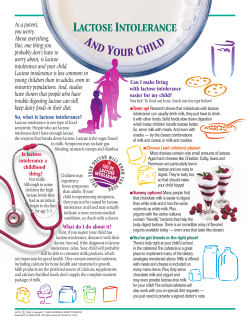
Milk Intolerance vs. Milk Allergy groups: almost 100% in Southeast Asia.
Milk Intolerance vs. Milk Allergy Introduction: One of the most commonly diagnosed conditions in infants is milk intolerance. Milk Intolerance includes lactose intolerance, and milk protein allergy. I. Lactose Intolerance: Positive family history common. Major differences in different ethnic groups: almost 100% in Southeast Asia. If parents say that they themselves have never "liked" milk, then it is likely that they are milk intolerant. Can have a complete intolerance in which case symptoms will be induced by any lactose containing food (such as yogurt, ice cream, cheese), or incomplete, in which case just switching milks will be enough to control symptoms. Milks that contain lactose: 1. Breast Milk; 2. Enfamil, Similac, Gerber, Carnation Milks that do not contain lactose: 1. Lacto-free; 2. Prosobee, Isomil; 3. Nutramigen, Pregestimil, Alimentum Symptoms of lactose intolerance in infants and children: 1. Irritability: from gas pains; can start in infancy but more likely to show up in older children. 2. Bloating and distension 3. Diarrhea and increased spitting up 4. Sleeplessness: more related to milk protein allergy. 5. In older children: recurrent abdominal pain 6. In adults, relationship with irritable bowel syndrome and with osteoporosis (dec intake) Diagnosis of lactose intolerance: usually trial and error, but can be diagnosed by the: - breath hydrogen test. Usually available only after consultation with gastroenterologist. This test is based on higher amounts of hydrogen in the breath due to activity of enteric bacteria producing it in those with lactose intolerance. Normal children absorb the sugar in the small int. II. Milk Protein Allergy - often associated with SOY allergy. An IgE mechanism for some children (those better off with soy than predigested formulas), but not demonstrated in most. No precise mechanism of immunological rxn described. Symptoms: In infants, symptoms can be restricted to those of lactose intolerance, but can also include the following: 1. Severe abdominal cramps: may show up only as a sleep disturbance. 2. Bloody diarrhea: can be microscopic or gross blood 3. Vomiting severely 4. Enteropathies: varying combinations of malabsorption, steatorrhea, and hypoalbuminemia. 5. Heiner’s Syndrome: pulmonary hemosiderosis with pulmonary infiltrates. Diagnosis: Elimination, re-introduction with return of symptoms. Skin testing: IgE: not always helpful. RAST tests: for soy unreliable. No advantage over skin testing. Treatment: Because of high correlation with soy allergies, it makes sense to switch children from whatever formula they are on to a predigested formula rather than a soy: Pregestimil, Nutramigen or Alimentum. If this not tolerated then consider goat’s milk - but must supplement folic acid because of megaloblastic anemia. Should boil goat’s milk first because of brucellosis. Recommendation: Do not get in the habit of switching formulas around because of parental concern over gas pains. Formulas – Which Gets Used When? Taking a Rational Approach to the Choice of Formula Contemporary Peds, August 2001, 18(8): 112-30. Introduction. The bane of the pediatrician’s existence are parents who never can find exactly the right formula for their baby. Many myths exist in our society about formulas. Formula intolerance varies from 10-30% depending on the definition of intolerance. Classification of formulas: 1. Iron – supplemented (10-12 mg Fe/liter): vs. “low-iron” (now 4-5 mg Fe/liter): No indication for low iron formula: AAP has asked to have taken off the market. Harmful effects of switching: risk neurodevelopment problems. 2. Cow’s Milk vs the others: Cow’s milk made up of: a. 43% calories as carbohydrate (lactose) b. 50% calories as fat (vegetable oil) c. Protein (nonhydrolyzed cow-milk protein) 3. Premature Discharge Formulas: for babies born before 34 weeks gestation. (e.g. Neosure) Contain a higher caloric density, protein content and calcium and phosphorus content than standard formulas. Helps promote catch-up growth by 9 months of age. Also used to supplement (up to two feedings a day) breastfeeding. 4. Formulas for protein allergy: actual percentage is less than 6%: hypoallergenic formulas: a. casein hydrolysate (Alimentum, Pregestimil, Nutramigen) or b. Amino Acid formula (Neocate) c. Whey hydrolysate (Carnation good start); this contains some lactose 5. Lactose-free formula: (Lactofree): not indicated except possibly for those recovering from transient lactase deficiency after gastroenteritis. Not indicated galactosemia because trace amounts of lactose are in this type of formula. 6. Soy formulas. Contains sucrose, not lactose. They are supplemented now with iron, zinc and calcium. Not indicated for preterm infants in a special care nursery since use in this group has exacerbated demineralized skeletal status. Soy formulas also appropriate for those that want their children to be on a vegetarian diet. Also not as allergenic as cow-milk protein formulas. 7. Follow-up Formulas. No clear-cut advantage to using these; AAP – no role in toddler. Switching Formulas. How we can minimize this tendency: 1. Talk about this in prenatal examination as well as when visiting the nursery. Always state that breast milk is the best choice. 2. If switch indicated (parent insists, true intolerance), suggest a one-month trial of whichever formula parent requests. Reassure about irritability 3. If after a month, family wants another formula switch, colic is present, etc., then tell them to try hydrolysate formula – but warn them it is expensive and probably won’t help. Unanswerable situations: Partner suggested switching, other child needed to switch, nurse in your office told to switch, grandmother told parent to switch, etc.
© Copyright 2025





















